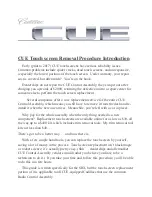
8. Maintenance
Under normal conditions the solar collector is maintenance free. Other system components such as the pump, glycol
liquid (if used) may require periodic inspection and changing/maintenance. Please refer to the documentation provided
by the manufacturer of these other components.
⚠
WARNING
APART FROM THOSE MAINTENANCE ITEMS OUTLINED BELOW, ANY
SYSTEM INSPECTION, MAINTENANCE OR REPAIR SHOULD ONLY BE
COMPLETED BY AUTHORISED PERSONS.
THE SOLAR COLLECTOR WARRANTY COVERAGE MAY BE VOID IF NON-
AUTHORISED PERSONS ATTEMPT TO MAINTAIN OR REPAIR THE SOLAR
COLLECTOR OR ASSOCIATED COMPONENTS.
HOME OWNER MAY ONLY COMPLETE THOSE MAINTENANCE
ACTIVITIES OUTLINED IN THIS DOCUMENT IF
SAFE
TO DO SO.
HOME OWNER MUST
NEVER
CLIMB ONTO A ROOF.
The following maintenance may be completed by HOME OWNER
8.1. Cleaning
a) If tubes become dirty they may be cleaned with high pressure water or glass cleaner.
b) Leaves may accumulate between or beneath the tubes and should be removed. The solar collector is NOT a
heat source that could ignite the leaves during hot water.
8.2. Other Components
Other system components such as the pump station or controller may have certain maintenance functions that can
be safely completed by the Home Owner. Refer to the owner’s manuals for those components for more
information.
The following maintenance may ONLY be completed by AUTHORISED PERSONS
8.3. Broken Tube Replacement
a) If a tube is broken it should be replaced as soon as possible to maintain maximum collector performance.
b) The system will still operate normally and safely even with a tube broken.
c) Any broken glass should be cleared away to prevent injury.
d) To replace a tube, follow these guidelines:
• Remove the tube clip(s), slide broken tube out and carefully pick up any glass pieces. Protective gloves must
be worn when handling broken glass, and avoid touching the glass wool insulation with bare hands, as it can
cause mild skin irritation.
• When removing the broken tube, the rubber ring in the manifold casing may pop out. Just return this ring into
place before inserting the new tube.
• If the heat pipe is not easily removed (commonly the case), it can be left in place and a new evacuated tube
inserted, guiding the heat pipe down the groove between the evacuated tube inner wall and heat transfer fin.
• If the heat pipe is easily removed, the easiest option is to replace the heat pipe and evacuated completely.
8.4. Insulation
a) The plumbing pipes running to and from the collector should be heavily insulated. This insulation foam should be
checked periodically (at least once every 3 years) for damage.
Apricus Solar Collector Installation and Operation Manual - International Edition
Copyright ©
2013 – Apricus Solar Co., Ltd A11-01.1.1-PB-V16 Page 22 of 27






































